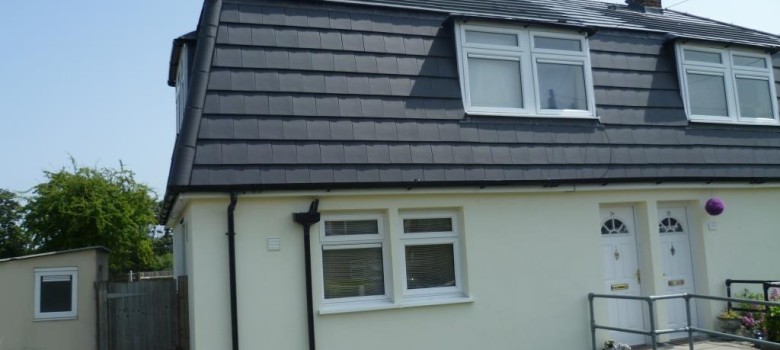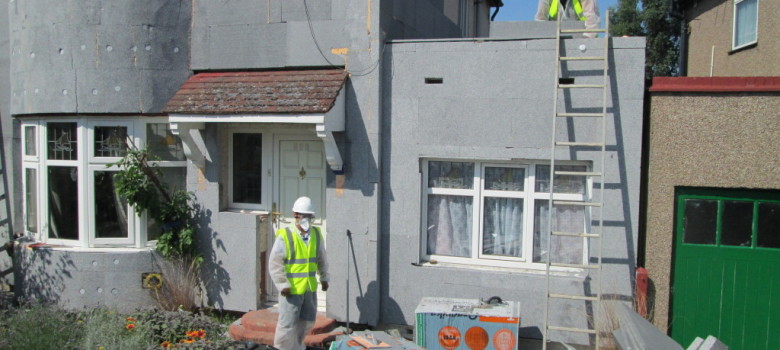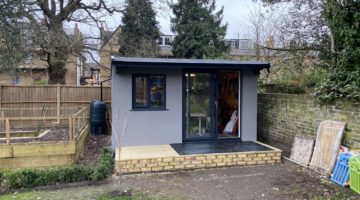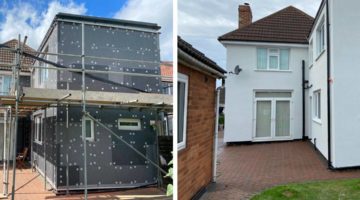
Why should you render a property?
When you walk down a typical street in town, you will see a mixture of properties. Some are more modern, some are older, some will have exposed brick, some will have a coloured render applied. You might ask why some properties have a render finish and others don’t – good question! Let’s try and take you through the various reasons for rendering your property…
Reason 1 – Aesthetics
The number one reason historically for rendering a property is to improve the look. Adding a render coat can really brighten up a shabby looking wall, and it gives the opportunity to give the whole house a facelift.
Some properties can have a real mish-mash of brick types, unattractive wear from years of exposure, or just look tired and unattractive. Adding a layer of render gives you the opportunity to completely change the look of the property – giving you a smooth uniform finish. Back in the 70’s that seemed to mean pebbledash, but nowadays the standard is usually a white smooth render.
If your render is old and tired, or perhaps cracked, it might be necessary to re-render also. This will involve stripping off the old render and starting afresh on the exposed wall. You may also have painted brickwork, which tends to get scruffy looking very quickly; in which case installing render would be a good alternative to having to re-paint every few years.
Obviously beauty is very much in the eye of the beholder though – we do still love the brick look!

Another reason people choose to render their homes is to deal with water ingress and penetrating damp issues. Some forms of brick, especially in exposed areas, can be liable to damp if exposed to the elements over a prolonged period of time. Water gets through the solid brick wall and in to the house, causing a host of problems in the home. Adding a layer of render to the outside wall of the home blocks the path of water in to the property and prevents this form of damp from occurring. Of course, this is only really the case on older solid brick properties. If you have a cavity wall, you shouldn’t be getting penetrating damp like this.
Remember – if you have damp issues before rendering your property, get an expert to take a look and let you know the best course of action. In some situations, render will not be the answer, and where rendering is appropriate, the type of render used will be important – so do your research if you are trying to deal with damp.
Reason 3 – Improve thermal performance
Rendering your property will provide a slight insulating effect of its own, but if you are rendering, it is a great time to consider full external insulation.
External solid wall insulation is an expensive job – but so is rendering, and if you are putting scaffolding up and getting a contractor to render, this is the best and cheapest time to look as external insulation. A typical cost for rendering a property is £50-60 per square meter, whilst external insulation with render is around £100 per square meter, so insulating at the same time is going to be great value. You can also benefit from various grant monies that are available for insulation, but not for rendering.
We have found that some of our customers actually end up spending less on external insulation with a render finish than they would on rendering alone – and they then get to see masses of savings on their energy bills in to the bargain.
Choosing the right render
Getting the right type of render is really important, as each type has different properties that could benefit your property or exacerbate problems.
We typically use one of three types of render:
Acrylic – This is the cheapest type of render and can provide really vibrant colours. The drawback is that it is not breathable – and this can be an issue for some properties.
Mineral – This type of render is very tough wearing, and is somewhat breathable. It is the mid price option and is usually suitable for most instances.
Silicone Silicate – This type of render is the most expensive, but is lots of beneficial properties – it is self cleaning and breathable. One downside is that it can only really be installed in the summer months as it needs milder temperatures to be able to dry.
Is rendering worth it?
There are several really good reasons for looking to render your property, even if you live in a more modern house. Having said this, you are looking at a considerable cost – rendering is not going to be worth it for everyone. Think carefully about the type of render you want to go for and whether you want to insulate at the same time – because this is an investment that is going to be on your wall for many, many years and it is going to be costly to remove or replace.













Do you render in your external wires?
Hi Meredith, the installation company should remove the wiring away from the walls, install the rendering solution and then refix on top. Tidiest jobs I have seen have the ‘external trunking’ and they can be tucked away on corners or away from the high visibility areas to make the visuals look good. Depends on the installer, but jobs we have seen with trunking of wires on the surface look pretty good.
Hi, i am interested in removing my existing render on my property and installing a new render to replace it. Have you got any local installers in the Bath area that might be able to help
Will rendering affect any internal parts of the house or any items inside the house or is it just external?